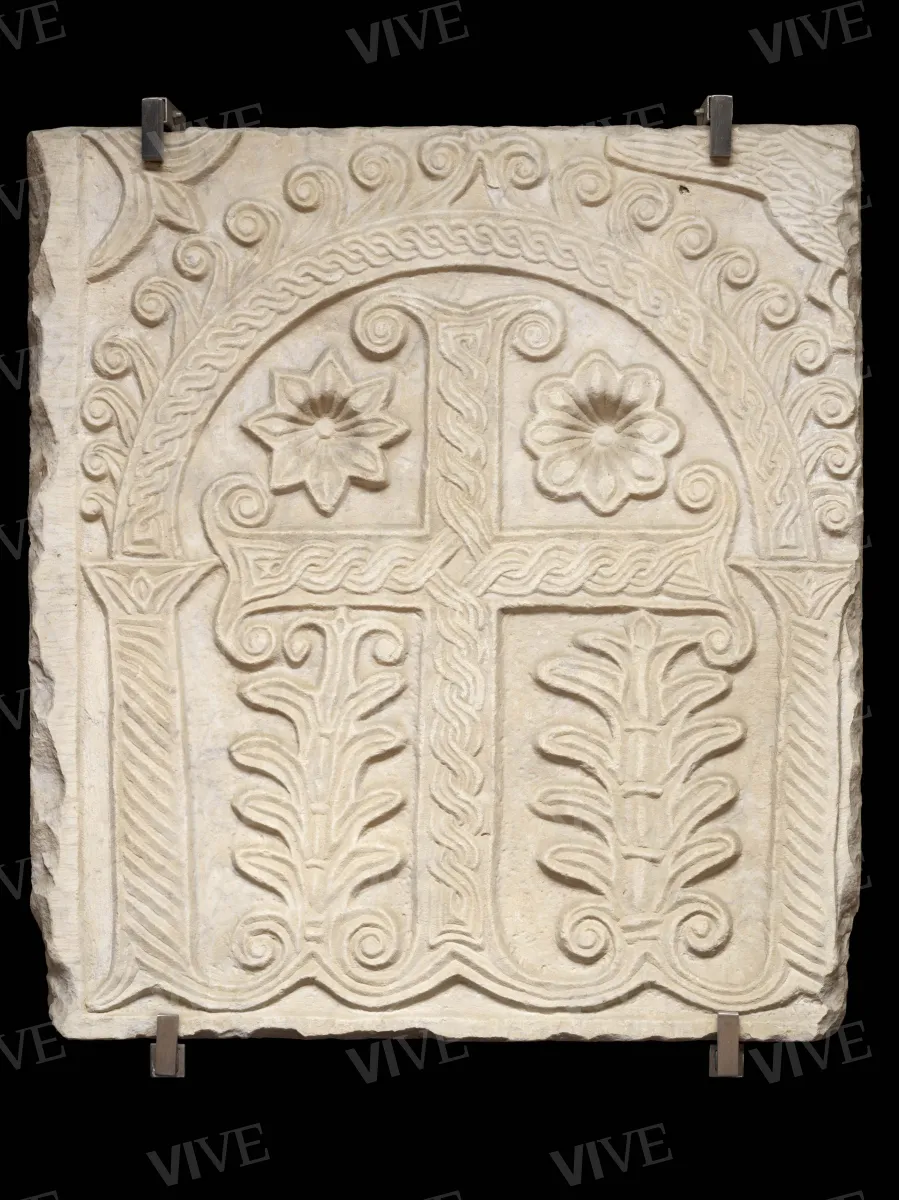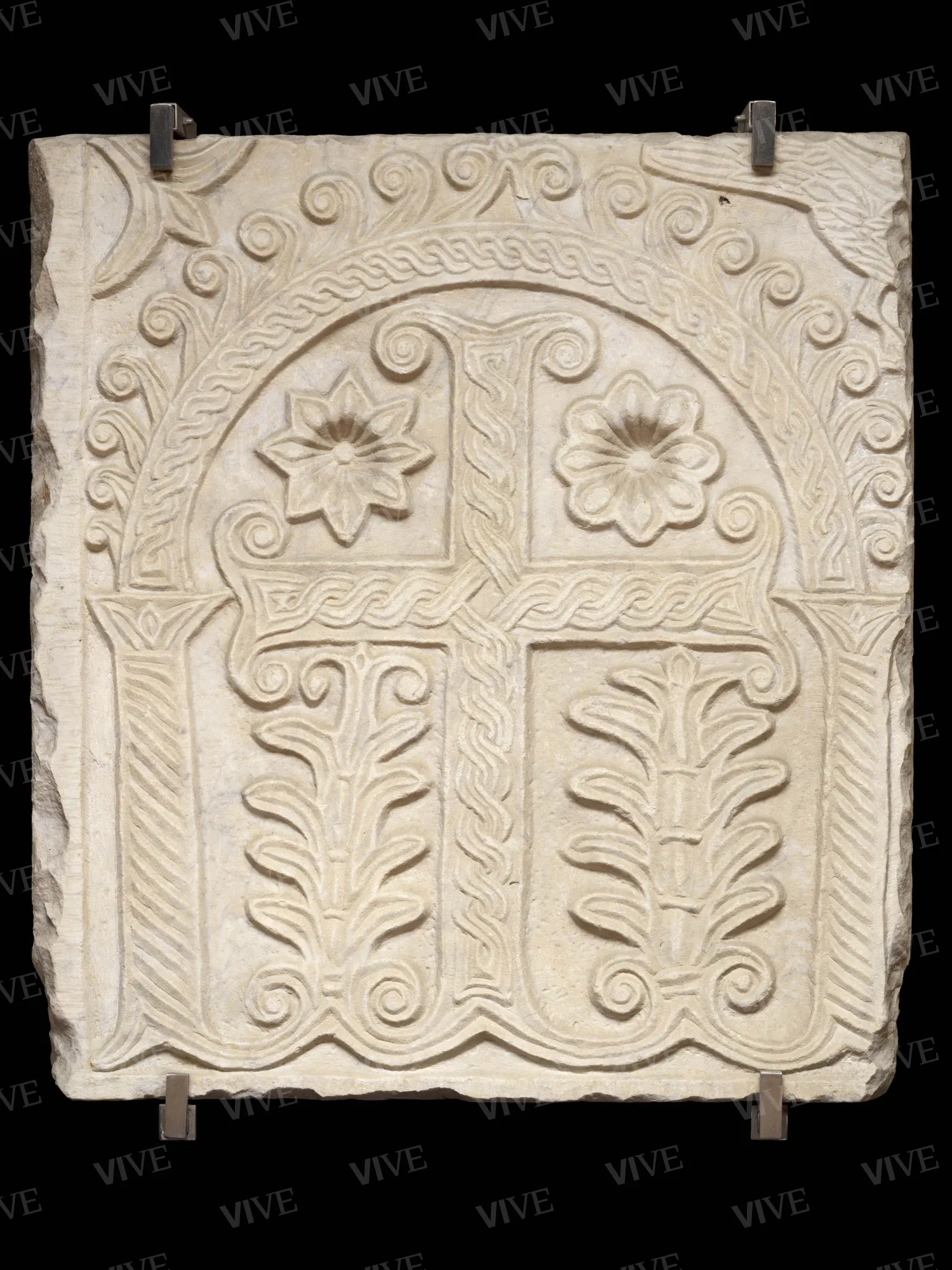Fragmentary pluteus or antependium with cross within aedicula
Roman milieu Mid-9th century
Fragmentary marble pluteus or antependium with a plain listel frame, decorated by an aedicula with small Solomonic columns, foliate capital, and guilloche-ornamented round arch, framing an interlaced cross with scrolled extremities, flanked by palmettes with cauliculi and strigilated leaves and recessed rosettes. The arch is surmounted by a divergent double row of recurring waves and bears a fleur-de-lis and the hind side of a bird in the spandrels.
Fragmentary marble pluteus or antependium with a plain listel frame, decorated by an aedicula with small Solomonic columns, foliate capital, and guilloche-ornamented round arch, framing an interlaced cross with scrolled extremities, flanked by palmettes with cauliculi and strigilated leaves and recessed rosettes. The arch is surmounted by a divergent double row of recurring waves and bears a fleur-de-lis and the hind side of a bird in the spandrels.
Details of work
Catalog entry
The fragmentary white Carrara marble slab is most likely the left half of an antependium or presbytery enclosure pluteus, originally decorated with crosses framed with an aedicula and bordered by a plain, listel frame with relief.
The aedicula consists of two intertwined columns, concluded by foliate capitals, on which is set a round arch with a guilloche pattern. Along it runs a double row of recurring waves fanning out from the central fleur-de-lis motif, known to early medieval Roman sculptural production as the Aeolian capital (Seminario 1976). In the center stands an interlaced Latin cross, or cross pattée, with splayed ends and broad scrolled extremities, connected at the base by means of a wave motif to two palmette-like saplings, arranged symmetrically on either side of the longitudinal arm. Specularly, the resulting spaces below the arch are occupied by two large rosettes with variously rounded or lance-shaped petals, set in the center of a corolla. Arranged in the spandrels are an inverted lily and bird, which is seen from behind, with carefully executed feathers, a cocked leg, and a long, parallel-etched tail.
The ornamental motif of the cross under the aedicula is of early Christian origin and relates to the iconography of the Anastasis (Pani Ermini 1974b), taking upon itself a complex set of symbolic values (Roth-Rubi 2015), referring to the Tree of Life (the palms flanking the cross), Paradise (the aedicula as the gateway to Paradise), the cosmological order (the rosettes as the sun and moon), and salvation through Christ (the sacrifice of the cross). It seems to have been used in early medieval Roman sculptural production as early as at the presbytery enclosure of St. Peter’s in the Vatican at the time of Gregory III (731–741) (Guiglia Guidobaldi 2002; Ballardini 2008) and became popular in Rome and central and northern Italy in the first half of the ninth century. It is sometimes associated with other symbols, be they phytomorphic, such as palmettes and lilies, or zoomorphic, especially birds such as peacocks and doves.
The missing half of the bird on the right spandrel and its size suggest that the carved decoration continued on that side with a matching aedicula (reconstructive hypothesis in Latini 2003, fig. 30): possible comparisons call into question a fragment from the Museo dell’Alto Medioevo (Melucco Vaccaro, Paroli 1995, fig. 29), fragments from Santa Maria in Aracoeli (Pani Ermini 1974, figs. 25 and 42, but not the so-called “Paliotto dell’Aracoeli” if it is now considered a forgery, Gianandrea 2021), a fragment from San Giorgio al Velabro (Melucco Vaccaro 1974, fig. 16), and especially a fragment from San Lorenzo fuori le mura (Broccoli 1981, fig. 176), all dated to the second quarter of the ninth century.
On the typological and formal level, the pluteus or antependium is in keeping with an established repertoire of models, but it also displays a disparity in quality between individual elements that is attributable to different, variously skilled workers. The rosettes, for example, are well designed and distinct in the two types with rounded and lance-shaped petals. Equally solid is the artistry of the albeit cropped figure of the bird. In contrast, the horizontal arm of the cross and the palmettes below exhibit flaws in composition and carving techniques.
Rosettes with recessed hearts were already part of the repertoire of the Lombard area and appeared in Rome as early as during Hadrian I’s papacy (772–795) in the furnishings of Santa Maria in Cosmedin (Melucco Vaccaro 1974, fig. 106). But it is among the fragments from the Round Temple in the Forum Boarium (Melucco Vaccaro 1974, fig. 264), dated to the second quarter of the ninth century, that we find more certain examples. Similarly, during Leo III’s papacy (795–816) the palmettes used to decorate the ciborium arch or pergula at the church of Santi Bonifacio e Alessio (Trinci Cecchelli 1976, figs. 16–17) are much less convincing than those we find in St. John Lateran (Melucco Vaccaro 1974, fig. 59) and San Cosimato (Kautzsch 1939, fig. 58), both from the second quarter of the ninth century.
It is more difficult to find analogies with the bird on the right spandrel. The position between two aediculae can be found in other slabs from the first half of the ninth century, such as the pluteus from the Museo dell’Alto Medioevo (Melucco Vaccaro, Paroli 1995, fig. 29), even though the definition of the details and the precision of the carving recall the peacock and birds on a slab at the Museo di Roma (Betti 2003, fig. 7) and—though it is less refined in execution than ours but, just like ours, placed in the spandrels between two aediculae—the peacock of the antependium from Sant’Alessandro (Broccoli 1981, fig. 176), both dated to the mid-ninth century.
The slab was repurposed, as the epigraph on the verso indicates, at an unspecified date, and its original destination remains equally obscure, since we do not know the early medieval details regarding the old church of San Trifone in posterula, later Sant’Agostino in Campo Marzio, from which it appears to have come as part of a group of works that the Giunta liquidatrice dell'asse ecclesiastico (Liquidating council of the ecclesiastical axis) had assigned to the Museo Artistico Industriale by royal decree in 1876. The church, founded in the eighth–ninth centuries, had been completely rebuilt as early as 1006 by the urban prefect Crescentius, from 1287 had been conceded to the Augustinians by Pope Honorius IV, and was then demolished in the eighteenth century when the Augustinian convent was extended (Picardi 2005).
If stylistically the slab belongs to a period close to the middle of the ninth century, it might be interesting to speculate that the church of San Trifone may have been the object of care of those popes, such as Gregory IV (827–844) and Leo IV (847–855), who, at the end of a glorious reaffirmation of papal power, introduced a vast program of restoration and embellishment of religious buildings in Rome (Melucco Vaccaro 2001). This is nothing more than conjecture, however, given the absence of records for the period and in light of the church’s ostensibly modest role prior to its early medieval refoundation (Hüls 1976).
Valentina Brancone
State of conservation
Good. Cropped right and scored on three sides.
Restorations and analyses
2002–2003: restoration directed by Maria Giulia Barberini and Maria Selene Sconci, conducted for the new layout of the Museo di Palazzo Venezia Lapidarium.
Inscriptions
Epigraph engraved on verso of slab “REVERENDI PATRES HUIUS / CANOBII MONUMENTO / LOCUM IN PERPETUUM / ASSIGNARUNT.”
Provenance
Rome, from the church of San Trifone in posterula, then Sant’Agostino in Campo Marzio;
Rome, from 1876 in the Museo Artistico Industriale;
Rome, Palazzo Venezia since 1957.
Sources and documents
Erculei Raffaele, Museo del Medio Evo e del Rinascimento per lo studio dell’Arte applicata all’Industria. Catalogo per l’anno 1876, Rome 1876, no. 789;
Rome, Archivio Storico Capitolino, Elenco degli oggetti d’arte che si conservano presso il Museo Artistico Industriale, 1884. Attached to Delibera del Consiglio Comunale n. 13, October 27, 1884, no. 72;
Rome, Archivio della Galleria Nazionale d’Arte Antica di Palazzo Barberini, Libro 5° dell’inventario, Fondo M.A.I., manuscript edited by V. Rosati, A. Ferrari, G. Ferrari, n.d. (early twentieth century), no. 33;
Ferrari Giulio, Museo Artistico Industriale di Roma. Catalogo delle collezioni, Rome 1906, page 15, no. 32;
Rome, Archivio del Museo del Palazzo di Venezia, Resoconto della riunione per la concessione degli oggetti del Museo Artistico Industriale in deposito al Museo di Palazzo Venezia (August 5, 1952, Prof. E. Lavagnino, Prof. A. M. Colini, Dr. C. Pietrangeli, Prof. A. Santangelo), with attached inventory, no. 1222.
Seminario sulla tecnica e il linguaggio della scultura a Roma tra VIII e IX secolo, in Atti del simposio su Roma e l'Età carolingia, coordinated by Avagnina Maria Elisa, Istituto di Archeologia e Storia dell'arte, Rome 1976.
References
Kautzsch Rudolf, Die römische Schmuckkunst in Stein vom 6. bis zum 10 Jahrhundert, in «Römisches Jahrbuch für Kunstgeschichte», III, 1939, pp. 3-73;
Melucco Vaccaro Alessandra, La Diocesi di Roma, t. III, La II regione ecclesiastica, Corpus della scultura altomedievale, VII, Spoleto 1974;
Pani Ermini Letizia, La Diocesi di Roma, t. I, La IV regione ecclesiastica, Corpus della scultura altomedievale, VII, Spoleto 1974;
Pani Ermini Letizia, La Diocesi di Roma, t. II, La raccolta dei Fori imperiali, Corpus della scultura altomedievale, VII, Spoleto 1974 (Pani Ermini 1974b);
Macchiarella Gianclaudio et al., Seminario sulla tecnica e il linguaggio della scultura a Roma tra VIII e IX secolo, in Roma e l’età carolingia. Atti delle giornate di studio 3-8 maggio 1976, a cura dell’Istituto di Storia dell’Arte dell’Università di Roma, Roma 1976, pp. 267-288;
Trinci Cecchelli Margherita, La Diocesi di Roma, t. IV, La I regione ecclesiastica, Corpus della scultura altomedievale, VII, Spoleto 1976;
Hüls Rudolf, Sui primordi di S. Trifone a Roma, in «Archivio della Società Romana di Storia Patria», III s., 99 (1976), pp. 336-341;
Broccoli Umberto, La Diocesi di Roma, t. V, Il Suburbio. 1, Corpus della scultura altomedievale, VII, Spoleto 1981;
Melucco Vaccaro Alessandra, Paroli Lidia, La Diocesi di Roma, t. VI, Il Museo dell’alto Medioevo, Corpus della scultura altomedievale, VII, Spoleto 1995;
Melucco Vaccaro Alessandra, Le botteghe dei lapicidi: dalla lettura stilistica all’analisi delle tecniche di produzione, in Roma nell’Alto Medioevo, Settimane di studio del Centro italiano di studi sull’Alto Medioevo, 48, Spoleto 2001, pp. 393-420;
Guiglia Guidobaldi Alessandra, La scultura di arredo liturgico nelle chiese di Roma: il momento bizantino, in Guidobaldi Federico, Guiglia Guidobaldi Alessandra (a cura di), Ecclesiae urbis. Atti del Congresso internazionale di studi sulle chiese di Roma (IV-X secolo), (Roma, 4-10 settembre 2000), III, Città del Vaticano 2002, pp. 1479-1524;
Betti Fabio, Sculture carolingie del Lapidario del Museo di Roma: materiale inedito e contesti di provenienza, in «Bollettino del Musei Comunali di Roma», XVII, n.s. 2003, pp. 142-161;
Latini Massimo, Sculture altomedievali inedite del Museo Nazionale del Palazzo di Venezia in Roma, in «Rivista dell’Istituto Nazionale d’Archeologia e Storia dell’Arte», 57, 2003, pp. 113-152;
Picardi Paola, Il caso di Sant’Agostino e Santa Maria del Popolo: relitti e rimozioni, in Garibaldi Vittoria, Toscano Bruno (a cura di), Arnolfo di Cambio. Una rinascita nell’Umbria medievale, Milano 2005, pp. 97-101;
Barberini Maria Giulia, Quintiliani Giulia, Raimondo Filippo, Palazzo Venezia, il Palazzetto e il suo Lapidarium. Un viaggio tra i frammenti della Storia di Roma, Roma 2006;
Ballardini Antonella, Scultura per l’arredo liturgico nella Roma di Pasquale I: tra modelli paleocristiani e Flechtwerk, in Quintavalle Arturo Carlo (a cura di), Medioevo: arte e storia, X Convegno internazionale di studi (Pavia, 18-22 settembre 2007), Milano-Parma 2008, pp. 225-246;
Latini Massimo, in Barberini Maria Giulia (a cura di), Tracce di pietra. La collezione dei marmi di Palazzo Venezia, Roma 2008, pp. 175-194, schede 1-29;
Roth-Rubi Katrin (in collaborazione con Sennhauser Rudolph), Die frühe Marmorskulptur aus dem Kloster St. Johann in Müstair, Ostfildern 2015;
Gianandrea Manuela, Riflessioni e qualche novità su alcune sculture altomedievali ora al Museo dell’Alto Medioevo a Roma, in D’Achille Anna Maria et al. (a cura di), Domus sapienter staurata. Scritti di storia dell’arte per Marina Righetti, Cinisello Balsamo 2021, pp. 176-183.












